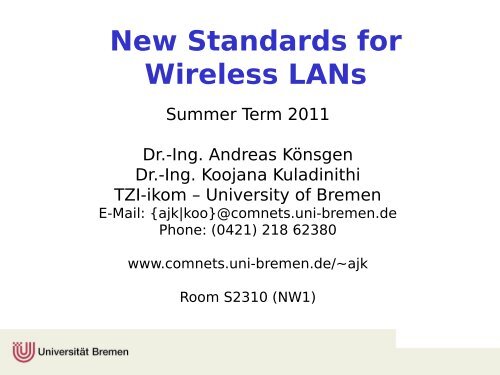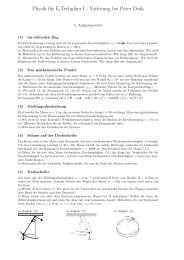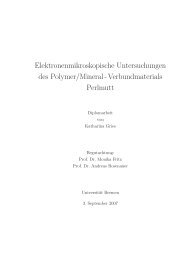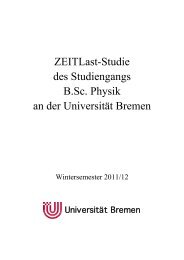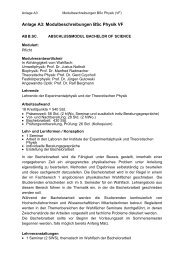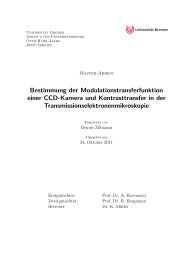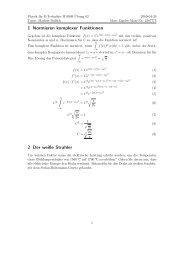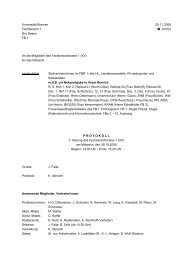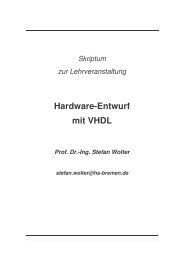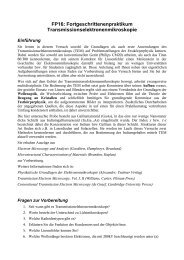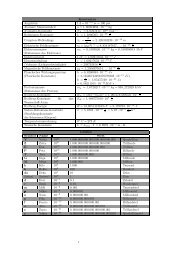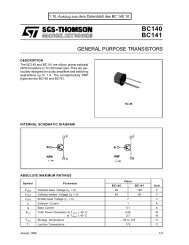New Standards for Wireless LANs
New Standards for Wireless LANs
New Standards for Wireless LANs
Create successful ePaper yourself
Turn your PDF publications into a flip-book with our unique Google optimized e-Paper software.
<strong>New</strong> <strong>Standards</strong> <strong>for</strong><br />
<strong>Wireless</strong> <strong>LANs</strong><br />
Summer Term 2011<br />
Dr.-Ing. Andreas Könsgen<br />
Dr.-Ing. Koojana Kuladinithi<br />
TZI-ikom – University of Bremen<br />
E-Mail: {ajk|koo}@comnets.uni-bremen.de<br />
Phone: (0421) 218 62380<br />
www.comnets.uni-bremen.de/~ajk<br />
Room S2310 (NW1)
Acknowledgement<br />
This lecture is based on material by<br />
Prof. Dr.-Ing. Andreas Timm-Giel<br />
Institute of Communication Networks<br />
Technical University of Hamburg-Harburg<br />
Germany<br />
- 2 -<br />
TZI – FB 1 – Kommunikationsnetze<br />
Andreas Könsgen – Summer Term 2011
Exam:<br />
Organisational Issues<br />
• Oral Exam (30min) after the end of the term<br />
Questions, Critics etc.:<br />
• always welcome<br />
How to reach me?<br />
• In my office S2310, or send an e-mail<br />
Exercises:<br />
• After the lecture, S 1270, 11:00 to 11:45<br />
• deepen understanding, open discussion, some<br />
labs/demos/simulation<br />
• Slides available on www.comnets.uni-bremen.de<br />
under “WLAN course”<br />
- 3 -<br />
TZI – FB 1 – Kommunikationsnetze<br />
Andreas Könsgen – Summer Term 2011
No lecture/tutorial:<br />
Organisational Issues<br />
• 25 April because of Easter holidays<br />
• 13 June because of public holiday<br />
– Will be taken at some other date<br />
– To be fixed later<br />
- 4 -<br />
TZI – FB 1 – Kommunikationsnetze<br />
Andreas Könsgen – Summer Term 2011
Objective of the Lecture<br />
● Understand wireless technologies: how do<br />
they work?<br />
● Give an overview on existing and emerging<br />
wireless standards<br />
● Give an idea what is coming up in the<br />
future in <strong>Wireless</strong> Communications<br />
- 5 -<br />
TZI – FB 1 – Kommunikationsnetze<br />
Andreas Könsgen – Summer Term 2011
Overview:<br />
Course Overview (1)<br />
● Mobile and <strong>Wireless</strong> Communications Basics<br />
― radio propagation<br />
― Modulation and coding<br />
― multiple access, duplex schemes, access protocols<br />
● IEEE 802.11(<strong>Wireless</strong> LAN)<br />
— Overview 802.11 a, b, g, h...<br />
— Physical Layer<br />
— MAC Layer<br />
— Security<br />
- 6 -<br />
TZI – FB 1 – Kommunikationsnetze<br />
Andreas Könsgen – Summer Term 2011
Course Overview (2)<br />
● IEEE 802.16 – <strong>Wireless</strong> Metropolitan Area Network<br />
(WMAN) – WiMAX<br />
● IEEE 802.20 – Mobile Broadband <strong>Wireless</strong> Access<br />
(MBWA)<br />
● IEEE 802.15 – <strong>Wireless</strong> Personal Area Network<br />
(WPAN): Bluetooth and Zigbee<br />
● Sensor Networks (Dr. Koojana Kuladinithi)<br />
- 7 -<br />
TZI – FB 1 – Kommunikationsnetze<br />
Andreas Könsgen – Summer Term 2011
Literature<br />
• See Website – www.comnets.uni-bremen.de<br />
• Jochen Schiller – Mobilkommunikation, Pearson, 2003,<br />
available in English, from Addison-Wesley.<br />
• James F. Kurose, Keith W. Ross, Computer Networking – A top-<br />
Down Approach, 4 th Edition, 2008, Pearson International<br />
Edition<br />
• Bernhard H. Walke – Mobile Radio Networks, J. Wiley & Sons,<br />
1999<br />
• Walke, UMTS – the fundamentals<br />
• IEEE Standardisation documents (links on website)<br />
• Many others, like:<br />
– K. David/T. Benkner, Digitale Mobilfunksysteme, Teubner,<br />
1996<br />
– Kammeyer, Nachrichtenübertragung, Teubner, 1996<br />
- 8 -<br />
TZI – FB 1 – Kommunikationsnetze<br />
Andreas Könsgen – Summer Term 2011
Chapter 1: First Mobile and<br />
<strong>Wireless</strong> Communication<br />
Systems
Definition of <strong>Wireless</strong> and Mobile<br />
• <strong>Wireless</strong><br />
– Communication without wires, can be<br />
mobile and fixed<br />
• Mobile<br />
– Portable devices (laptops, notebooks etc.)<br />
connected at different location to wired<br />
networks (e.g. LAN or PSTN)<br />
– Portable devices (phones, notebooks,<br />
PDAs etc.) connected to wireless networks<br />
(UMTS, GSM, WLAN….)<br />
- 10 -<br />
TZI – FB 1 – Kommunikationsnetze<br />
Andreas Könsgen – Summer Term 2011
Early History of <strong>Wireless</strong> Communications<br />
• In history first light and sound have been used to transmit<br />
messages over wide distances<br />
- 11 -<br />
Pics from http://www.connected-earth.com<br />
TZI – FB 1 – Kommunikationsnetze<br />
Andreas Könsgen – Summer Term 2011
Transmission of Electromagnetic Waves<br />
• 1831: Faraday demonstrates<br />
magnetic induction<br />
• 1865: Maxwell theory of<br />
electromagnetic fields, wave<br />
equation<br />
• 1876 Patent on phone, Alexander<br />
Graham Bell (Antonio Meucci 1849)<br />
• 1888: H. Hertz: demonstrates<br />
the wave character of electrical<br />
transmission through space<br />
• Nikola Tesla extends the<br />
transmission range<br />
Pics from www.wikipedia.org<br />
- 12 -<br />
TZI – FB 1 – Kommunikationsnetze<br />
Andreas Könsgen – Summer Term 2011
History of <strong>Wireless</strong> Communication<br />
• 1895 Guglielmo Marconi<br />
– first demonstration of wireless<br />
telegraphy (digital!)<br />
– 1901 transatlantic transmission<br />
– long wave transmission, high<br />
transmission power necessary (> 200kW)<br />
• 1907 Commercial transatlantic connections<br />
– huge base stations<br />
(30 100m high antennas)<br />
• 1915 <strong>Wireless</strong> voice transmission <strong>New</strong> York - San Francisco<br />
• 1920 Discovery of short waves by Marconi<br />
– reflection at the ionosphere<br />
- 13 -<br />
Foto from www.wikipedia.org<br />
– smaller sender and receiver, possible due to the invention of the<br />
vacuum tube (1906, Lee DeForest and Robert von Lieben)<br />
TZI – FB 1 – Kommunikationsnetze<br />
Andreas Könsgen – Summer Term 2011
1924<br />
Beginning of Mobile Communications<br />
• 1911 mobile transmitter on Zeppelin<br />
• 1926 train (Hamburg – Berlin)<br />
• 1927 first commercial car radio (receive only)<br />
• First Mobile Communication Systems started<br />
in the 40s in the US and in the 50s in Europe.<br />
- 14 -<br />
CONCEPTS:<br />
• Large Areas per<br />
Transmitter<br />
• „Mobiles“ large, high<br />
power consumption<br />
• Systems low capacity,<br />
interference-prone<br />
• Expensive !!!<br />
TZI – FB 1 – Kommunikationsnetze<br />
Andreas Könsgen – Summer Term 2011
Today's <strong>Wireless</strong> Communication (1)<br />
1984 CT-1 standard (Europe) <strong>for</strong> cordless telephones<br />
– In Germany selling no longer permitted since 2009<br />
1992 DECT<br />
– Digital European Cordless Telephone (today: Digital<br />
Enhanced Cordless Telecommunications)<br />
– 1880-1900MHz, ~100-500m range, 120 duplex channels,<br />
1.2Mbit/s data transmission, voice encryption,<br />
authentication, up to several 10000 user/km 2 , used in<br />
more than 50 countries<br />
1996 HiperLAN (High Per<strong>for</strong>mance Radio Local Area<br />
Network)<br />
– ETSI, standardization of type 1: 5.15 - 5.30GHz, 23.5Mbit/s<br />
– recommendations <strong>for</strong> type 2 and 3 (both 5GHz) and 4<br />
(17GHz) as wireless ATM-networks (up to 155Mbit/s)<br />
– Did not enter market<br />
- 15 -<br />
TZI – FB 1 – Kommunikationsnetze<br />
Andreas Könsgen – Summer Term 2011
Today's <strong>Wireless</strong> Communications (2)<br />
In the 1990s: many proprietary products <strong>for</strong> wireless<br />
networks<br />
1997 <strong>Wireless</strong> LAN – IEEE standard 802.11<br />
2.4-2.5 GHz and infrared, 2Mbit/s<br />
1999 IEEE 802.11b, 2.4 GHz, 11Mbit/s<br />
1999 IEEE 802.11a, 5 GHz, 54 Mbit/s<br />
1999/2001 Bluetooth/IEEE 802.15.1 <strong>for</strong> piconets,<br />
2.4 GHz, < 1Mbit/s<br />
2003 IEEE 802.11g, 2.4 GHz, 54 Mbit/s<br />
2003/2004 Zigbee/IEEE 802.15.4 <strong>for</strong> sensor networks<br />
2009 IEEE 802.11n, 2.4 and 5 GHz, 600 Mbit/s<br />
- 16 -<br />
TZI – FB 1 – Kommunikationsnetze<br />
Andreas Könsgen – Summer Term 2011
End Chapter 1
Chapter 2 – Mobile<br />
Communications<br />
Definitions & Basics
Chapter 2 - Overview<br />
• Part 1 (today)<br />
– Digital Transmission System<br />
– Frequencies, Spectrum Allocation<br />
– Radio Propagation and Radio Channels<br />
• Part 2 (next week)<br />
– Modulation, Coding, Error Correction<br />
• Part 3 (in 2 weeks)<br />
– Capacity limits<br />
– Duplexing schemes<br />
– Media Access Protocols<br />
- 19 -<br />
TZI – FB 1 – Kommunikationsnetze<br />
Andreas Könsgen – Summer Term 2011
Acknowledgement<br />
• Pictures and some slides of this chapter are<br />
taken from:<br />
– B. Walke, P. Seidenberg, M. P. Althof,<br />
UMTS: the fundamentals, Wiley<br />
– Schiller: Mobilkommunikation (Mobile<br />
Communications), Pearson<br />
Studium/Addison Wesley, 2003/2002<br />
– David/Benkner: Digitale<br />
Mobilfunksysteme, Teubner 1996<br />
– Proakis/Saleh, Grundlagen der<br />
Kommunikationstechnik, Pearson Studium<br />
2004<br />
- 20 -<br />
TZI – FB 1 – Kommunikationsnetze<br />
Andreas Könsgen – Summer Term 2011
Application<br />
Transport<br />
Network<br />
Data Link<br />
Physical<br />
Simple Reference Model<br />
Radio<br />
Network Network<br />
Data Link<br />
Physical<br />
Data Link<br />
Physical<br />
- 21 -<br />
Wired Medium<br />
Application<br />
Transport<br />
Network<br />
Data Link<br />
Physical<br />
TZI – FB 1 – Kommunikationsnetze<br />
Andreas Könsgen – Summer Term 2011
More Detailed Reference Model<br />
• Application layer<br />
• Transport layer<br />
• Network layer<br />
• Data link layer<br />
• Physical layer<br />
– service location<br />
– new applications, multimedia<br />
– adaptive applications<br />
– congestion and flow control<br />
– quality of service<br />
– addressing, routing,<br />
device location<br />
– Hand-over<br />
– authentication<br />
– media access<br />
– multiplexing<br />
– media access control<br />
– encryption<br />
– modulation<br />
– interference<br />
– attenuation<br />
– frequency<br />
- 22 -<br />
TZI – FB 1 – Kommunikationsnetze<br />
Andreas Könsgen – Summer Term 2011
Structure of Digital Transmission System<br />
Digital Source<br />
Sink<br />
- 23 -<br />
TZI – FB 1 – Kommunikationsnetze<br />
Andreas Könsgen – Summer Term 2011
twisted<br />
pair<br />
1000 km<br />
300 Hz<br />
Frequencies <strong>for</strong> Communication<br />
10 km<br />
30 kHz<br />
coax cable<br />
100 m<br />
3 MHz<br />
VLF LF MF HF VHF UHF SHF EHF infrared visible<br />
light<br />
UV<br />
VLF = Very Low Frequency UHF = Ultra High Frequency<br />
LF = Low Frequency SHF = Super High Frequency<br />
MF = Medium Frequency EHF = Extra High Frequency<br />
HF = High Frequency UV = Ultraviolet Light<br />
VHF = Very High Frequency<br />
Frequency and wave length:<br />
λ = c /f<br />
1 m<br />
300 MHz<br />
With wave length λ, speed of light c ≈ 310 8 m/s, frequency f<br />
- 24 -<br />
10 mm<br />
30 GHz<br />
100 μm<br />
3 THz<br />
optical transmission<br />
1 μm<br />
300 THz<br />
TZI – FB 1 – Kommunikationsnetze<br />
Andreas Könsgen – Summer Term 2011
Frequencies <strong>for</strong> Mobile Communication<br />
• VHF-/UHF-ranges <strong>for</strong> mobile radio<br />
– simple, small antenna <strong>for</strong> cars<br />
– deterministic propagation characteristics, reliable<br />
connections<br />
• SHF and higher <strong>for</strong> directed radio links, satellite<br />
communication<br />
– small antenna, focusing<br />
– large bandwidth available<br />
• <strong>Wireless</strong> <strong>LANs</strong> use frequencies in UHF to SHF spectrum<br />
– some systems planned up to EHF<br />
– limitations due to absorption by water and oxygen<br />
molecules (resonance frequencies)<br />
• weather dependent fading, signal loss caused by heavy<br />
rainfall etc.<br />
- 25 -<br />
TZI – FB 1 – Kommunikationsnetze<br />
Andreas Könsgen – Summer Term 2011
Frequency Regulations<br />
• Frequency assignments are managed by the International<br />
Telecommunication Union –<br />
Radiocommuncation Sector (ITU-R)<br />
– holds auctions <strong>for</strong> new frequencies, manages frequency<br />
bands worldwide (WRC, World Radio Conferences)<br />
• National regulation authorities<br />
– Germany: Bundesnetzagentur (Federal Network Agency)<br />
– USA: Federal Communications Commission (FCC)<br />
- 26 -<br />
TZI – FB 1 – Kommunikationsnetze<br />
Andreas Könsgen – Summer Term 2011
Important Frequency Assignments<br />
Cellular<br />
Phones<br />
Cordless<br />
Phones<br />
<strong>Wireless</strong><br />
<strong>LANs</strong><br />
Europe USA Japan<br />
GSM 450-457, 479-<br />
486/460-467,489-<br />
496, 890-915/935-<br />
960,<br />
1710-1785/1805-<br />
1880<br />
UMTS (FDD) 1920-<br />
1980, 2110-2190<br />
UMTS (TDD) 1900-<br />
1920, 2020-2025<br />
CT1+ 885-887, 930-<br />
932<br />
CT2<br />
864-868<br />
DECT<br />
1880-1900<br />
IEEE 802.11<br />
2400-2483<br />
HIPERLAN 2<br />
5150-5350, 5470-<br />
5725<br />
Others RF-Control<br />
27, 128, 418, 433,<br />
868<br />
AMPS, TDMA, CDMA<br />
824-849,<br />
869-894<br />
TDMA, CDMA, GSM<br />
1850-1910,<br />
1930-1990<br />
PACS 1850-1910, 1930-<br />
1990<br />
PACS-UB 1910-1930<br />
902-928<br />
IEEE 802.11<br />
2400-2483<br />
5150-5350, 5725-5825<br />
RF-Control<br />
315, 915<br />
- 27 -<br />
PDC<br />
810-826,<br />
940-956,<br />
1429-1465,<br />
1477-1513<br />
PHS<br />
1895-1918<br />
JCT<br />
254-380<br />
IEEE 802.11<br />
2471-2497<br />
5150-5250<br />
RF-Control<br />
426, 868<br />
TZI – FB 1 – Kommunikationsnetze<br />
Andreas Könsgen – Summer Term 2011
ISM Bands: General facts<br />
Industrial, scientific, and medical (ISM) radio bands<br />
• originally reserved internationally by ITU-R <strong>for</strong> noncommercial<br />
use of RF electromagnetic fields <strong>for</strong><br />
industrial, scientific and medical purposes<br />
• Individual countries' use may differ due to variations in<br />
national radio regulations<br />
• In recent years permission <strong>for</strong> license-free short-range<br />
communication applications such as walkie-talkies,<br />
remote controls, <strong>Wireless</strong> <strong>LANs</strong>, Bluetooth<br />
Source: Wikipedia<br />
- 28 -<br />
TZI – FB 1 – Kommunikationsnetze<br />
Andreas Könsgen – Summer Term 2011
ISM Bands: Assignments<br />
Some typical ISM bands<br />
Frequency Comment<br />
13.553-13.567 MHz<br />
26.957-27.28 MHz<br />
40.66-40.70 MHz<br />
433-434 MHz Europe<br />
900-928 MHz America<br />
2.4-2.5 GHz WLAN/WPAN<br />
5.725-5.875 GHz WLAN<br />
24-24.25 GHz<br />
- 29 -<br />
TZI – FB 1 – Kommunikationsnetze<br />
Andreas Könsgen – Summer Term 2011
Signal Propagation<br />
● Propagation in free space always like light (straight line)<br />
● Receiving power in free space proportional to 1/d²<br />
(d = distance between sender and receiver)<br />
● Sources of distortion<br />
● Reflection/refraction – bounce of a surface; enter material<br />
● Scattering – multiple reflections at rough surfaces<br />
● Diffraction – start “new wave” from a sharp edge<br />
● Doppler fading – shift in frequencies (loss of center)<br />
● Attenuation – energy is distributed to larger areas with<br />
increasing distance<br />
reflection refraction scattering diffraction<br />
- 30 -<br />
TZI – FB 1 – Kommunikationsnetze<br />
Andreas Könsgen – Summer Term 2011
Attenuation results in path loss<br />
• Effect of attenuation: received signal strength is a<br />
function of the distance d between sender and<br />
transmitter<br />
• Captured by Frii's free-space equation<br />
– Describes signal strength at distance d relative<br />
to some reference distance d 0 < d <strong>for</strong> which<br />
strength is known<br />
– d 0 is far-field distance, depends on antenna<br />
technology<br />
- 31 -<br />
TZI – FB 1 – Kommunikationsnetze<br />
Andreas Könsgen – Summer Term 2011
Pathloss in Free Space<br />
• Received power depends on frequency,<br />
transmitted power, antenna gains, distance and<br />
constants only<br />
P<br />
L<br />
L<br />
F<br />
R<br />
=<br />
P<br />
T<br />
⎛<br />
⎜<br />
⎝<br />
λ<br />
4πd<br />
⎞<br />
⎟<br />
⎠<br />
• EIRP: effective isotropic radiated power:<br />
– EIRP = P T G T<br />
2<br />
P<br />
( dB)<br />
= 10log<br />
P<br />
( dB)<br />
= 10log<br />
G<br />
R<br />
T<br />
G<br />
T<br />
T<br />
G<br />
R<br />
F f : Frequency [Hz]<br />
+ 10logG<br />
R<br />
- 32 -<br />
P<br />
G<br />
λ<br />
:<br />
d<br />
T / R<br />
T / R<br />
:<br />
:<br />
− 20log<br />
transmitted<br />
: Antenna Gain Transmitter/Receiver<br />
Wavelength[m]<br />
Distance[m]<br />
f<br />
/ received<br />
− 20log<br />
d<br />
Power<br />
+ 147.<br />
56<br />
TZI – FB 1 – Kommunikationsnetze<br />
Andreas Könsgen – Summer Term 2011
Attenuation of different frequencies<br />
● Attenuation depends on the<br />
used frequency<br />
● Can result in a<br />
frequency-selective channel<br />
― If bandwidth spans<br />
frequency ranges with<br />
different attenuation<br />
properties<br />
Attenuation<br />
- 33 -<br />
moderate rain<br />
fog / clouds<br />
strong rain<br />
molecular dispersion<br />
frequency<br />
TZI – FB 1 – Kommunikationsnetze<br />
Andreas Könsgen – Summer Term 2011
Atmospheric attenuation<br />
(dB/km)<br />
10<br />
1<br />
0.1<br />
0.01<br />
Attenuation in Atmosphere<br />
10 20 40 60 80 100 300 f (GHz)<br />
- 34 -<br />
vapor<br />
oxygen<br />
David Benkner:<br />
Digitale Mobilfunksysteme<br />
TZI – FB 1 – Kommunikationsnetze<br />
Andreas Könsgen – Summer Term 2011
• Signal can take many different paths between sender and<br />
receiver due to reflection, scattering, diffraction<br />
signal at sender<br />
Multipath Propagation<br />
• Time dispersion: signal is dispersed over time<br />
interference with “neighbor” symbols, Inter Symbol<br />
Interference (ISI)<br />
• The signal reaches a receiver directly and phase shifted<br />
distorted signal depending on the phases of the different parts<br />
- 35 -<br />
LOS pulses multipath<br />
pulses<br />
signal at receiver<br />
TZI – FB 1 – Kommunikationsnetze<br />
Andreas Könsgen – Summer Term 2011
Channel characteristics change over time and location<br />
– signal paths change<br />
– different delay variations of different signal parts<br />
– different phases of signal parts<br />
quick changes in the power received (short term/fast<br />
fading)<br />
Additional changes in<br />
Multipath Propagation<br />
– distance to sender<br />
– obstacles further away<br />
slow changes in the average power<br />
received (long term/slow fading)<br />
All fading effects are frequency-dependent<br />
- 36 -<br />
power<br />
short term fading<br />
long term<br />
fading<br />
TZI – FB 1 – Kommunikationsnetze<br />
Andreas Könsgen – Summer Term 2011<br />
t
Radio Channel Characteristics<br />
• Superposition of<br />
numerous direct and<br />
reflected multipath<br />
components with<br />
different attenuation<br />
and phasing<br />
• time variant<br />
• Differentiation of fast<br />
and slow fading<br />
• Fast fading due to superposition of different phases<br />
• Slow fading is due to the change of propagation<br />
environment<br />
• Both fading types depend on the frequency<br />
A<br />
- 37 -<br />
B<br />
TZI – FB 1 – Kommunikationsnetze<br />
Andreas Könsgen – Summer Term 2011
Real World Example: Propagation<br />
- 38 -<br />
TZI – FB 1 – Kommunikationsnetze<br />
Andreas Könsgen – Summer Term 2011
Real World Example: Time variation<br />
Signal<br />
amplitude<br />
5.18<br />
Frequency (GHz)<br />
Carrier frequency: 5.2 GHz<br />
Channel bandwidth: 40 MHz<br />
5.22<br />
- 39 -<br />
0<br />
0.5<br />
time (s)<br />
1<br />
TZI – FB 1 – Kommunikationsnetze<br />
Andreas Könsgen – Summer Term 2011
Real World Example: Path Loss<br />
• Received power of<br />
a sender is<br />
decreasing with the<br />
distance between<br />
sender and<br />
receiver<br />
• Depends on<br />
Frequency<br />
• Many models, e.g.<br />
Okumura-Hata<br />
Walfish-Ikegami<br />
UMTS 30.03<br />
• Mostly shown in dB<br />
(attenuation)<br />
Pathloss [dB]<br />
40 60 80 100 120 140 160<br />
0 200 400 600 800 1000<br />
- 40 -<br />
Distance [m]<br />
UMTS 30.03 Vehicular<br />
From Walke: UMTS - the fundamentals<br />
TZI – FB 1 – Kommunikationsnetze<br />
Andreas Könsgen – Summer Term 2011
Noise and Interference<br />
• So far: only a single transmitter assumed<br />
– Only disturbance: self-interference of a signal with multipath<br />
“copies” of itself<br />
• In reality, two further disturbances<br />
– Noise – due to effects in receiver electronics, depends<br />
on temperature<br />
• Typical model: an additive Gaussian variable, mean 0, no<br />
correlation in time<br />
– Interference from third parties<br />
• Co-channel interference: another sender uses the same<br />
spectrum<br />
• Adjacent-channel interference: another sender uses some<br />
other part of the radio spectrum, but receiver filters are not<br />
good enough to fully suppress it<br />
• Effect: Received signal is distorted by channel, corrupted by<br />
noise and interference<br />
- 41 -<br />
TZI – FB 1 – Kommunikationsnetze<br />
Andreas Könsgen – Summer Term 2011
Channel models<br />
• Simplest model: assume transmission power and<br />
attenuation are constant, noise an uncorrelated Gaussian<br />
variable<br />
– Additive White Gaussian Noise model<br />
• Situation with no line-of-sight path, but many indirect<br />
paths: Amplitude of resulting signal has a Rayleigh<br />
distribution (Rayleigh fading)<br />
• One dominant line-of-sight plus many indirect paths:<br />
Signal has a Rice distribution (Rice fading)<br />
• Raytracing model<br />
– Given location of transmitters, receivers, obstacles<br />
– Calculate current SINR <strong>for</strong> each transmission path<br />
- 42 -<br />
TZI – FB 1 – Kommunikationsnetze<br />
Andreas Könsgen – Summer Term 2011


